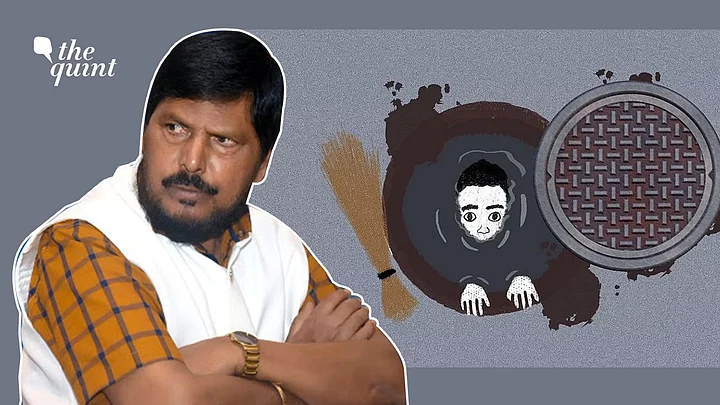(Editor's Note: The story was first published on 30 July 2021 and is being republished from The Quint's archives on 2 August 2022 in the light of Minister of State for Social Justice and Empowerment Ramdas Athawale reiterating in the Lok Sabha that no deaths have been reported due to manual scavenging in the last five years.)
On Wednesday, 28 July, Minister of State for Social Justice and Empowerment Ramdas Athawale stated that no deaths have been reported due to manual scavenging in the past five years.
Athawale made the statement in a written response to a question asked in the Rajya Sabha, by Mallikarjun Kharge and Dr L Hanumanthaiah, on manual scavenging, the deaths due to it, and rehabilitation of manual scavengers.
But, whom does the government consider as manual scavengers and who all are excluded from the criteria? Let's find out.
For Govt, Cleaners of Sewers Aren't Manual Scavengers
According to the data presented by the central government in the Lok Sabha in February this year, 340 people had lost their lives while cleaning sewers and septic tanks across the country during the last five years, up to 31 December 2020.
However, the government does not recognise people who regularly enter septic tanks and sewers for cleaning or maintenance as manual scavengers.
Speaking to The Quint, Bezwada Wilson, national convener of the Safai Karmachari Andolan (SKA) termed Athawale's statement as "inhumane," and said that the previous figures put out in the Parliament were also "incorrect."
"The actual number is 472 and not 340, according to our data. The data in the last Parliament session counted 132 fewer deaths than the actual number."Bezwada Wilson, national convener of the Safai Karmachari Andolan
Stating the the government was basing its current numbers on technicalities, Wilson said that the Ministry's figures don't add up.
"The people entering sewage lines and septic tanks will only die. Why will sweepers die under manual scavenging?" he questioned.
What Does MS Act, 2013 Say?
The Prohibition of Employment as Manual Scavengers and their Rehabilitation Act, 2013 (also known as the MS Act) deems manual scavengers to be persons engaged or employed by an individual or local authority for "manually cleaning, carrying, disposing of, or otherwise handling, in any manner, human excreta in an insanitary latrine or in open drain" before it fully decomposes.
The Act further states that the person must be engaged or employed on a regular or contract basis, and that persons involved in cleaning excreta with the help of "devices and using protective gear" shall not be deemed to be a 'manual scavenger.'
What About Caste & Gender Composition of Manual Scavengers?
When asked whether more than 90 percent of the employees in the sanitation and cleaning sectors are Dalits, Minister of State Ramdas Athawale told the Lok Sabha on 27 July, "no such data is maintained by this department."
As per SKA's website, manual scavenging includes workers engaged in cleaning drains, sewers, septic tanks, railway tracks, among others. It further notes that 98 percent of the people involved in manual scavenging are women and Dalits and that the caste system is such that "only people of certain Dalit sub-castes" clean others' excreta.
"Those born into these castes are forced to do manual scavenging until they die," the website added.
As per a research paper published on Economic & Political Weekly (EPW) in 2020, of the 1.2 million manual scavengers in India, 95-98 percent are women who belong to the following castes: Valmikis, Haila and Halalkhor castes, and from Mister and Dome castes.
"They are untouchables among untouchables, and are located at the lowest rung of the social order, and are ostracised by Dalits themselves," the paper titled as 'Manual Scavenging: Women Face Double Discrimination as Caste and Gender Inequalities Converge' added.
Meanwhile, the Ministry of Social Justice and Empowerment's annual report for the year 2020 -2021 states that a national survey was carried out in 194 districts that identified 51,835 manual scavengers up to 31 October 2020.
This figure was in addition to the 14,857 manual scavengers identified by 13 States as per the provisions of the Prohibition of Employment as Manual Scavengers and their Rehabilitation Act, 2013, taking the total to 66,692 manual scavengers.
Since, the survey does not account for all the districts across the country, the total number could be much higher.
Evidently, the Centre's statement in the Rajya Sabha on zero reported deaths due to manual scavenging is based on technicalities that exclude the people working in septic tanks from being considered as manual scavengers.
